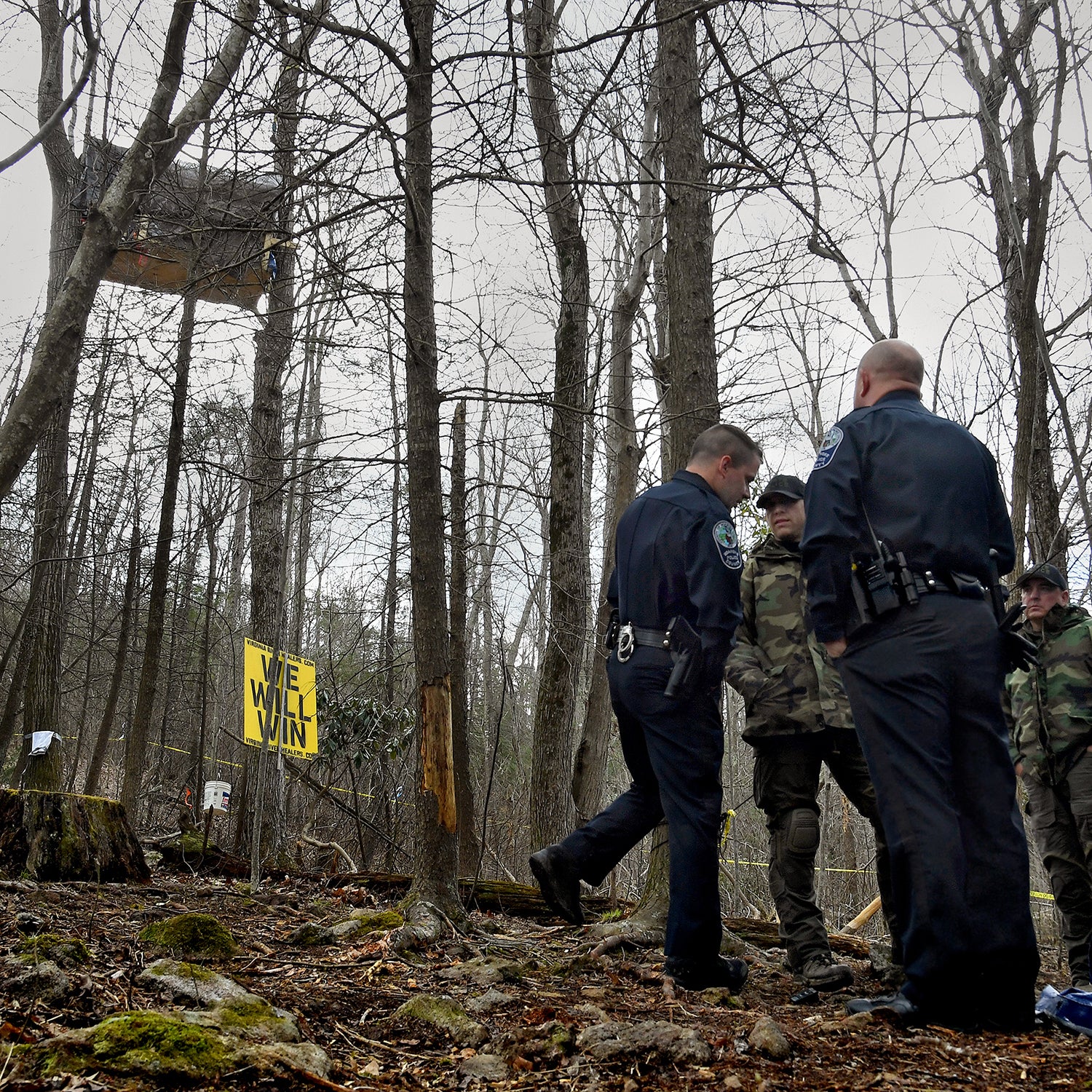For two months, protesters have sat in platforms perched among the trees near Peters Mountain, located in Jefferson National Forest. Their goal is to block logging in the area that will prepare the way for the Mountain Valley Pipeline, a 303-mile operation that will feed natural gas through the forest and cross the Appalachian Trail. And for two months the protests were peaceful, until last Sunday.
The protesters built their tree stands in February, and another protester erected a monopod—a freestanding perch atop a tall pole—at a separate site in late March. Since then, Forest Service officers and private security contractors paid by the pipeline owners have upped security at the sites. They restricted public access to the forest road that leads to the monopod. They issued an emergency closure within 150 feet of the structure, a move that has deprived the monopod-sitter, who goes by the trail name Nutty, of additional food and water supplies for at least three weeks now. On the other side of the mountain, the tree-sitters say private security contractors have harassed them with spotlights and loud noise throughout the night, preventing them from sleeping. The weather has been abysmal. They’re cold and tired.
And so on Sunday—Earth Day—about two dozen people made the hike up Peters Mountain to support the protesters. They brought musical instruments and food for a potluck. They staged political puppet shows and read poetry to the tree-sitters.
Doug Chancey, a 66-year-old retired addiction counselor who lives near the proposed pipeline, sat in the small support camp. He and others watched as several Forest Service officers left the area to check on the rally, and, recognizing the opportunity, Chancey and three others grabbed daypacks containing water, toilet paper, and food. They ducked the caution tape and walked as quickly as they could towards the monopod. And that, according to rally attendees and support-camp occupants, is when all hell broke loose.
Chancey says he and the other two individuals with backpacks were ordered to the ground by Forest Service officers. Chancey was handcuffed and put in leg shackles. Meanwhile, according to those on the scene, at least ten law-enforcement vehicles and over a dozen officers from multiple agencies arrived with assault rifles. (Law-enforcement agencies, including the Forest Service, did not respond to calls or e-mails. A spokesperson for the Virginia state police said that its officers did not arrive until after the arrests were made and that no officers drew their weapons at any time.)
Emily Satterwhite is associate professor of Appalachian studies at Virginia Tech University, where she has been studying the pipeline and those protesting it. She was on the scene of that weekend’s rally, and although she was not arrested, she was issued a $125 citation for violating the emergency closure—a claim she contests. What worries Satterwhite most is what such an aggressive response from law enforcement means for those hoping to take a stand against the pipeline.
“I don't expect to go to my national forest in support of a protector of the Appalachian Trail and be treated as if I don’t belong there,” Satterwhite says. “The Forest Service has turned into a private security detail for a pipeline corporation, and some of them seem to be relishing the exercise of power over peaceful campers.”
In some very real ways, the Mountain Valley Pipeline (MVP) is business as usual for the Forest Service and the National Park Service, which oversees the Appalachian Trail. About 60 pipelines currently cross the 2,200-mile National Scenic Trail. Management plans for protected areas like those around the AT allow for these projects, as long as they adhere to a forest’s “scenic integrity objectives, which require the Forest Service to protect and restore any degradation to the land.
Those objectives are where problems with the MVP began. In order to approve construction for the pipeline, the Forest Service had to modify its forest protection plan for the Jefferson National Forest and the AT. Prior to this weekend’s protests, I contacted JoBeth Brown, a spokesperson for the Forest Service, who said that following the Jefferson National Forest’s management plan was not feasible for the construction of the pipeline, so the federal government decided to alter them. These modifications allowed the agency to relax restrictions on a variety of issues, ranging from riparian damage to the clearing of old-growth trees to the impact of the pipeline on the AT.
“The decision to amend the forest plan was developed through extensive public involvement, Brown wrote to me in an e-mail. “The mitigation measures are required and would minimize the environmental impacts to the extent practical.”
Land owners, concerned individuals, and conservation groups have taken issue with both this decision and the Forest Service’s process to change the management plan. Andrew Downs, the central and southwest Virginia regional director for the Appalachian Trail Conservancy, says, “We’ve worked with the Forest Service and developers to put all sorts of infrastructure across the AT—power lines, pipelines, even roads. We’ve never had to amend the scenic integrity objectives in the forest plan. Until MVP.”
Last January, including the Sierra Club filed a suit in federal court to block the pipeline, arguing that its construction and operation would cause irreversible damage to surrounding lands and streams, as well as to the animals and plants nearby. It was the latest in that have been filed by NGOs and local residents whose land was seized by the private utility consortium that owns the pipeline project. These landowners are concerned with the safety of the project, which requires MVP to bore through fragile rock known as karst, which is very porous and can be unstable. They worry about the pipeline itself: at 42 inches in diameter and following a zigzagging route, it’s one of the nation’s most ambitious projects to date, both because of the size of the pipeline (most natural gas pipelines are no more than 36 inches in diameter) and the challenging terrain it crosses.
Maury Johnson, 58, is one such resident. He currently raises organic cattle on a farm that has been in his family since the early 1800s. MVP seized a wide swath of his pasture land through a provision of the 1938 Natural Gas Act, which allows utility companies to take private lands for infrastructure projects. Johnson says he is not only frustrated with having his family’s land taken, but also by the fact that the loss of land could have an impact on his business. For similar reasons, lots of locals have come out in strong support of the protestors. “I’ve told some of them if I were thirty years younger, I’d be with them,” Johnson says.
Late Sunday night, Chancey was released from custody with two tickets: one for entering a closed area and one for interfering with a forest officer. He was worried about Nutty’s condition and didn’t get much sleep that night, but he figures she didn’t either: her supplies must be getting low, and he says the Forest Service officers have set floodlights on the whole area.
Brown, the Forest Service spokesperson, says the agency isn’t allowed to comment on any ongoing litigation. But she did say that under federal regulation, her agency’s law-enforcement officers will continue to keep the area closed to anyone attempting to resupply the protesters in the tree platforms or on the monopod.
There’s no indication that Nutty plans to come down anytime soon. And the movement is catching on. Recently at least three other tree-sit protests have . Local residents are hopeful that the start of the hiking season will mean hikers on the AT will lend a hand. But they know opposition to their protests is increasing as well.
The pipeline project’s spokesperson, Natalie Cox, said it will continue to seek additional relief under federal injunction orders that allow MVP to prevent interference with construction.
“We have been patient in our attempts to consistently work with the handful of landowners that continue to impede MVP’s progress,” Cox wrote in an e-mail. “The most important message we want to send to landowners and residents in the region is that we’re going to do this the right way. We value the safety of our employees, contractors, and every single person that lives in these communities, and one of our primary goals remains the preservation and protection of the environment, as well as the protection of sensitive species and cultural and historic resources.”
Chancey says he isn’t buying it. Already his neighbors are complaining about their wells dirtied with sediment from the construction. He points to several endangered species in the area, including bats and plants. And from the vantage of the AT, there’s now a wide swath of missing trees on what is supposed to be a remote hike through wilderness.
“We’ve been at this for four years now,” Chancey says. “The real fight is just beginning. I have grandchildren. I want to be able to tell them that I tried to stop this environmental insanity.”


